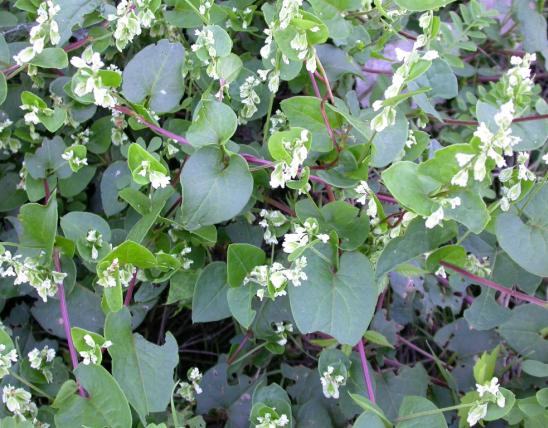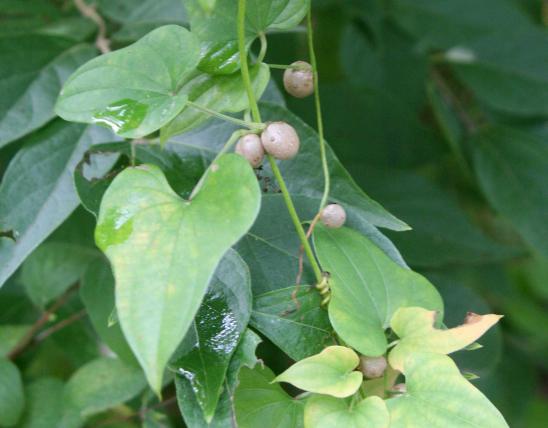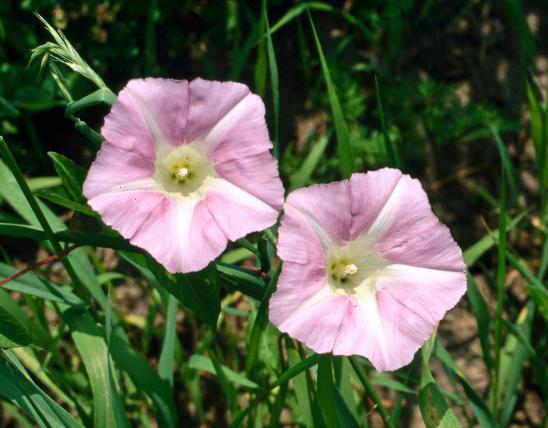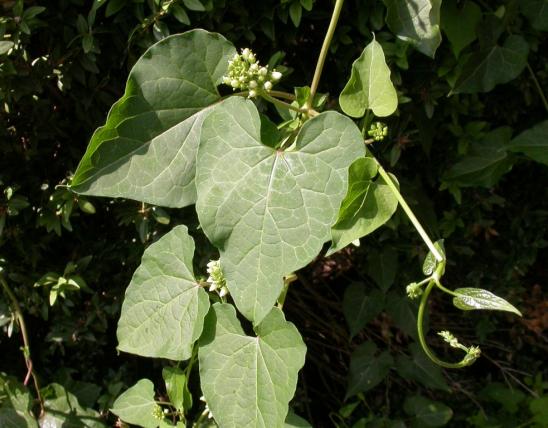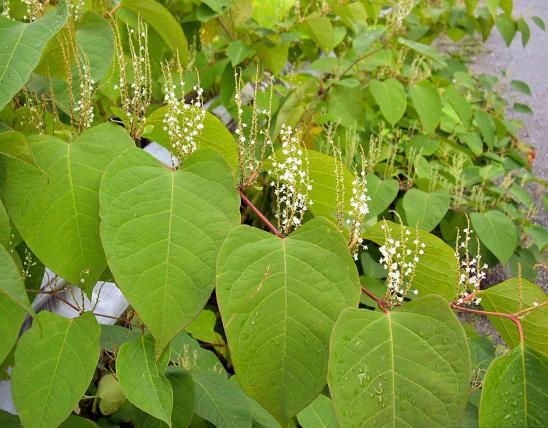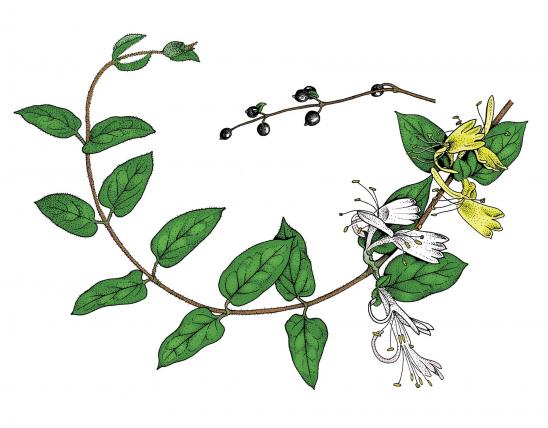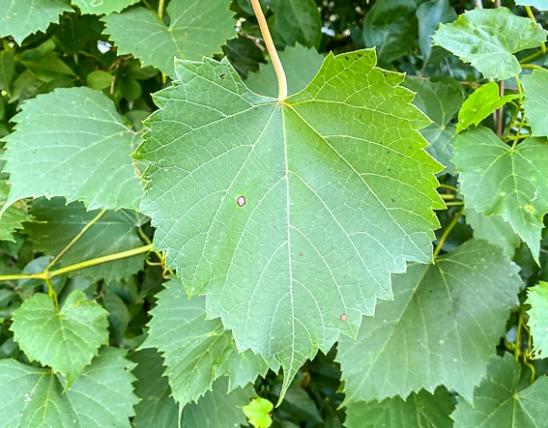
Bur cucumber is a nonwoody, annual vine common in low, moist soils along streams and roadways. A colony can spread across an area 20 feet in diameter, covering the ground and nearby shrubs and small trees. Identify it by its lobed, gourd-family leaves, curly green tendrils, clusters of prickly, green, oval fruits, and 5-lobed, cream-colored flowers.
Stems are slender (to only about 2 mm in diameter) and have hairs or bristles as well as branching, coiled tendrils that enable it to climb up shrubs and other vegetation and objects.
Leaves are alternate, with long, densely hairy leaf stems; blades can reach 8 inches long, roughly circular overall, palmately 5-lobed with usually 3 major lobes and 2 minor ones; the lobes broadly triangular, with the 3 major lobes having sharply pointed tips; the sinuses (angles between the major lobes) broadly rounded with an angle greater than 90 degrees; base heart-shaped; margins finely toothed; surfaces sparsely to densely hairy with tiny, nonsticky hairs. The upper surface is often rough to the touch.
Flowers are usually either male or female; both types usually occur on the same plant; petals are white to cream-colored, united into a saucer- or bell-shaped tube with 5 lobes. Male (staminate) flowers occur in stalked clusters (racemes) from the leaf axils; the filaments of the stamens are united to form a single stalk, and the anthers are fused into a headlike mass. Female (pistillate) flowers are less showy, sessile, in dense clusters at the tip of a stalk to 1½ inches long. Blooms June–October.
Fruits are in small, dense, headlike clusters; green, covered with slender, stiff, pale yellow prickles; egg-shaped, somewhat flattened, ½ to ¾ inch long; they are not inflated, do not split open at maturity, and contain 1 seed.
Similar species: Bur cucumber is one of several members of the gourd family that could possibly be found growing wild in Missouri. A number of those are nonnative escapes from cultivation, including watermelon, cantaloupe, cucumber, and bottle gourd. Among the native Missouri gourd-family plants are:
- Wild cucumber (Echinocystis lobata) is the species most similar to bur cucumber in Missouri. Note its 6-lobed (not 5-lobed) petal tubes, and leaf blades with ovate to oblong-triangular lobes, with the angle between the major lobes 90 degrees or less (while bur cucumber’s lobes are broadly triangular, with the angle between the major lobes more than 90 degrees). Wild cucumber’s fruits are ¾ to 1½ inches long and solitary, inflated, and 4-seeded.
- Melonleaf or fivelobe cucumber (Cayaponia quinqueloba) is uncommon in the Bootheel. Its fruits are solitary or paired, juicy, red, shiny berries.
- Buffalo guard, Missouri gourd, or stinking gourd (Cucurbita foetidissima), possibly introduced/not native, is uncommon and sporadic; it has not been collected in the state since the mid-1950s. This species was used extensively by Native Americans for food, for ceremonial rattles, for medicine, and more. The bad-smelling mature fruits are not edible.
- Wild pear gourd or yellow-flowered gourd (Cucurbita pepo var. ozarkana), scattered in the Ozarks, has a long history of cultivation going back to archaeological sites dated to about 10,000 years old. This species has been cultivated for the various fruit types that we know as summer squash, zucchini, acorn squash, pumpkins, and ornamental gourds (which themselves come in a bewildering array of shapes, colors, textures, etc.). The fruits of wild-type plants are usually 2–3 inches long, spherical, egg-shaped, or somewhat pear-shaped, and green, sometimes with faint irregular stripes, bleaching to ivory-colored at full maturity.
- Creeping cucumber (Melothria pendula) is uncommon in the Bootheel and southern parts of the Missouri Ozarks. Its fruits are solitary, juicy berries to ½ inch long, egg-shaped to nearly spherical, the rind thin and leathery, the surface green, mottled with darker and lighter green, becoming black with age, smooth (not spiny), glabrous, and glossy.
Stem length: to 16 feet or more. A patch of bur cucumbers can attain a remarkable size as its branching stalks spread across the ground and climb over and cover shrubs and small trees.
Scattered nearly statewide, but absent from most of the eastern half of northern Missouri’s glaciated plains.
Habitat and Conservation
Occurs on banks of streams and rivers, bottomland forest, and bases, ledges, and tops of bluffs. It also occurs in farmyards, along railroads and roadsides, and in disturbed areas.
In general, bur cucumber is found in low areas with moist, disturbed soils, where it can develop its branching stems to cover large areas 20 feet in diameter or more.
Being a frost-sensitive, annual, nonwoody vine, bur cucumber dies when it freezes and is less noticeable from late fall through spring. By late summer, the colonies can become eye-catching. People walking or biking the Katy Trail can see occasional big patches of bur cucumber and climbing false buckwheat along that former railroad line.
Status
Native annual, nonwoody vine.
Although bur cucumber is native to the eastern half of the United States, it is listed as a noxious weed in Indiana and Delaware.
Bur cucumber was introduced to Europe and Asia as far back as the 1800s. Initially grown there as an ornamental plant, it has spread to become an invasive weed on those continents. The seeds can survive in the soil and still germinate even after the parent plant has been gone for three years. Since it grows in bottomlands and along waterways, its seeds are readily dispersed during floods.
Human Connections
Bur cucumber is occasionally grown as an ornamental on arbors, but it is less attractive than its relative wild cucumber (Echinocystis lobata), with its showy clusters of male flowers and attractive foliage.
The leaves of bur cucumber can be cooked and eaten as greens. Apparently, the tender young leaves are best for this purpose.
Ecosystem Connections
A variety of bees, wasps, flies, and other pollinators visit the flowers for nectar, pollen, or both. The same kinds of insects that bedevil the squash, pumpkin, watermelon, and cucumber plants in your garden feed on bur cucumber, too, including several kinds of squash bugs, cucumber beetles, and leaf beetles. Keep in mind that insects that eat our many native plants provide a critical food source for birds.
The big mats of bur cucumber provide important cover for many kinds of animals, sheltering them from predators and from wind, sun, and rain.



































